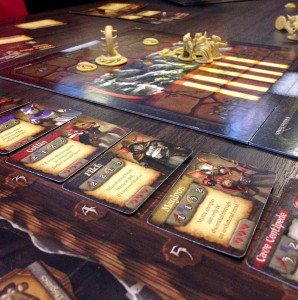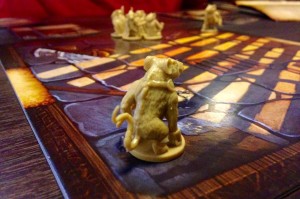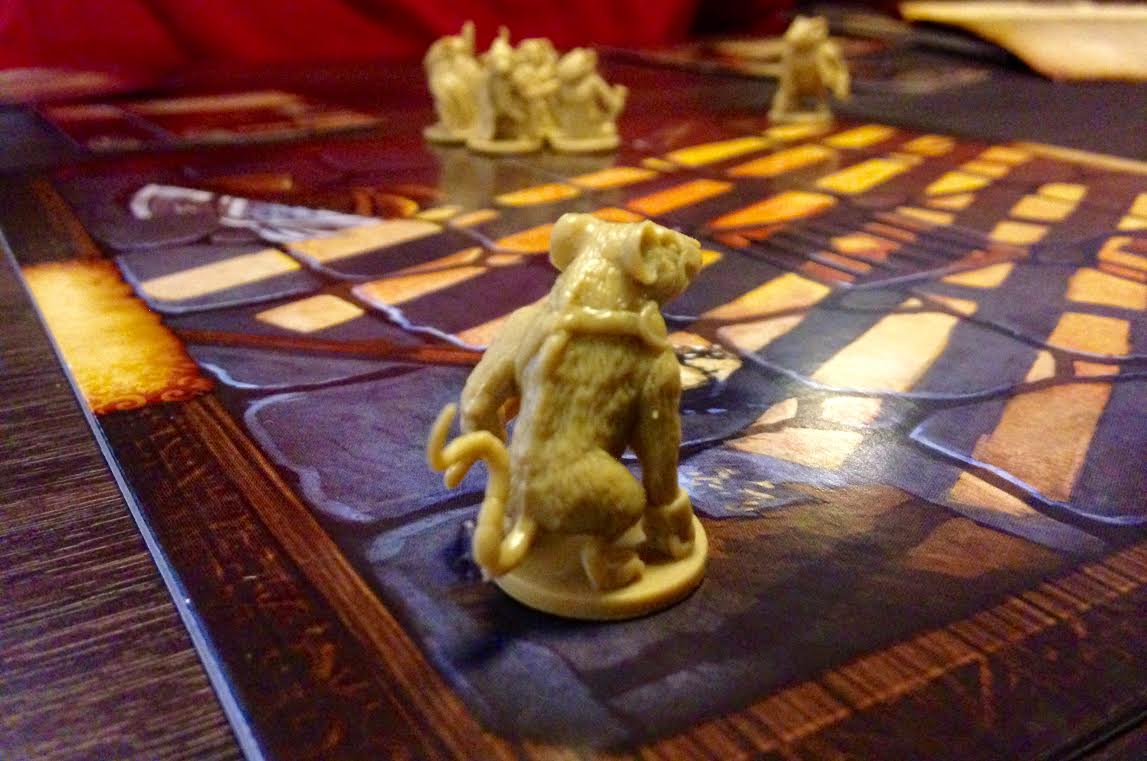This week’s Monday Night Gaming: Mice & Mystics Review
 Publisher: Plaid Hat Games
Publisher: Plaid Hat Games
# of Players: 1-4
Best with: 4
Playing Time: 60-90 minutes, though the first time, it’ll probably take you an hour just to read the rules & set up the board.
# of Expansions: 8
We were looking for a more complex game this time and stumbled upon Mice & Mystics. A friend of ours called it D&D in a box, and while it certainly has RPG elements, I wouldn’t go so far as to say that. Right out of the box, we knew it was going to be a lengthy set up as there are technically two rules books: one is the how to play guide while the other is all the rules of each chapter’s set up. The game begins with a father telling his child a bedtime story about a brave Prince who seeks to defeat the evil Vanestra. The prince and his friends are imprisoned and chose to change themselves into mice to escape. What makes this game so unique is that there are nine chapters to it. Each chapter can take about an hour to play through, making this a lengthy game. Players don’t have to play through all the chapters in one go. We played through chapter one and were defeated. Like Arkham Horror, it’s easy to die in a complicated game like this. Another thing I like about this game is that like Pathfinder and D&D, the game has additional storybooks (expansions) that can add to the story of Prince Collin and thus, add additional play of the game.
General Mechanics: This game is a cooperative adventure and dice game where players work together to make their way through various rooms as mice. Enemies like house cats, roaches, rats, and spiders try to stop the players as they move through the castle. In the base game, players can choose characters to play such as Maginos the Wizard, Nex Bellows the blacksmith, Prince Collin, the thief (whose name I forgot), Tilda the healer, etc. You’ll notice these are pretty stereotypical classes for RPGs.
The goal is for players to transverse the game tiles for a specific chapter so that they reach their end destination and save their kingdom.
 At the beginning of a round, players will shuffle the initiative cards and one at a time, place cards along the initiative track that runs down the side of the story control board. (The initiative deck is made up of player character cards and minions. Which minions are faced is determined by what chapter is being played. Which room tiles are used to create the story board is also determined by chapter.) The initiative track also determines the order in which players (and minions) will take their turns in that round.
At the beginning of a round, players will shuffle the initiative cards and one at a time, place cards along the initiative track that runs down the side of the story control board. (The initiative deck is made up of player character cards and minions. Which minions are faced is determined by what chapter is being played. Which room tiles are used to create the story board is also determined by chapter.) The initiative track also determines the order in which players (and minions) will take their turns in that round.
Players can perform 1 of the following actions and then move, or they can move and perform 1 action:
- Scurry–If a mouse has moved, it can roll the action die to move again as a scurry.
- Battle–players roll the action dice to attack based on the number of sword symbols, sword/shield symbols, and bow symbols. (Depending upon whether the mouse uses melee or ranged weapons, determines which symbols matter on attack.) Minions also get to roll during battle to determine whether they successfully block an attack.
- Search–Players roll the action die to search. If a particular symbol is rolled, the player can draw 1 card from the search deck. If it’s an item, weapon, armor, accessory, scroll, or trick, the player can either save it for later use, or discard it immediately for 1 cheese. (Cheese is used to cast spells, perform tricks, leveling up, etc.)
- Recover–stunned or webbed mice can use a recovery action to get rid of the effect.
- Explore–Players can’t do this unless all minions in a room are defeated. Explore is used to move mice from one room tile to another.
Players can also share, equip, or level up at any time during their turn. There are lots of rules about movement, especially movement over water, movement near traps, or movement across into other room tiles. There are also line of sight rules in regards to battle and movement.
The cheese mechanic is interesting because it forces the game to progress at a steady pace, whether the players are ready or not. Cheese can be used to level up or cast spells. But if an enemy gets cheese, it is added to the countdown clock. Then the clock is full, the story moves another page closer to its ending with a “surge” of enemies.
 How to Win/Lose: If the end of the story is reached before the mice achieve their victory conditions, then the game ends with a loss for the mice. Each chapter has its own victory conditions. To win, the players must complete these conditions before the hourglass marker moves onto the chapter end marker.
How to Win/Lose: If the end of the story is reached before the mice achieve their victory conditions, then the game ends with a loss for the mice. Each chapter has its own victory conditions. To win, the players must complete these conditions before the hourglass marker moves onto the chapter end marker.
What I Liked: While cheesy (yes, pun intended), the story line is cute, as are the detailed figurines included with the game. (We met another gamer while playing who had painted his miniatures and shared with us.)
What I Didn’t Like: Dice rolling games make luck more important than strategy. While incredibly fun, luck-based games can be frustrating for a serious gamer. I felt like the drawbacks for a ranged attack were too great, which greatly cripples anyone playing a ranged attack character.
Overall Rating/Impression: While the dice mechanics are a bit irritating, I genuinely liked the theme and feel of this game. It was enjoyable enough to own and play often. 9/10
Link to the lengthy rule book here.


